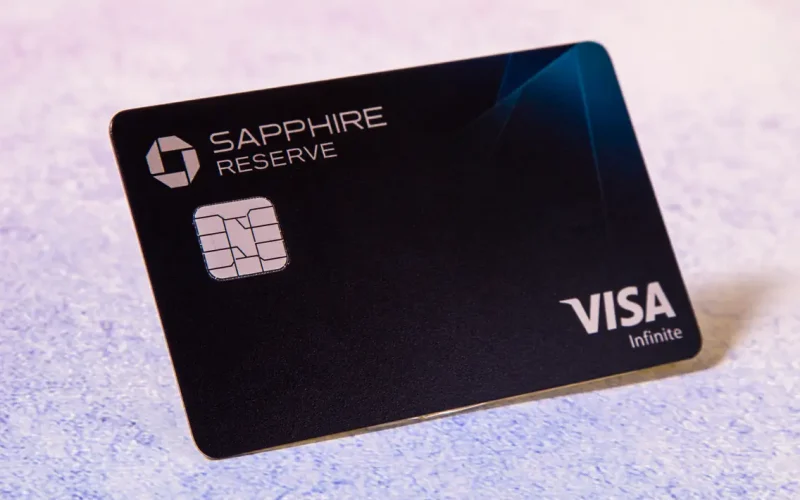Whether you’re traveling for business or pleasure, renting a car can be a convenient and flexible way to get around. Fortunately, if you’re a Chase Sapphire Reserve® or Chase Sapphire Preferred® Card cardholder, you have access to rental car insurance as one of the many benefits included with your credit card. The two Chase Sapphire cards provide virtually identical rental car insurance benefits, the only difference being the maximum liability covered.
This is because the prospect of getting into an accident or having your rental car stolen can be a significant source of anxiety for many travelers—and all the insurance options offered at the rental car company can be confusing, not to mention costly.
Car rental insurance you can get with Chase Sapphire Cards
Your Chase Sapphire card can provide an auto rental collision damage waiver (CDW) to reimburse damage caused by theft or collision. The Chase Sapphire Reserve covers losses up to $75,000 while the Chase Sapphire Preferred will reimburse up to the actual cash value of the vehicle.
In both cases, the Chase CDW also covers miscellaneous expenses, which can add up quickly: think loss-of-use charges passed on by the rental agency, towing fees or administrative fees.
The CDW (sometimes abbreviated as LDW or loss damage waiver) doesn’t cover any other type of loss. This means that if you’re in an accident in your rental car, damage to another driver’s vehicle or property or injury to a person is not covered by the Chase Sapphire CDW. In addition, although the rental car is covered for theft, the contents of the car are not covered. Hence, if the rental car is stolen, any personal property in the car, such as your luggage, would not be insured under the Chase Sapphire CDW.
Chase Sapphire’s CDWs coverage is considered primary coverage, meaning that Chase Sapphire will be the first insurance company to cover any damages or losses. Only rental periods up to 31 days are covered.
Coverage is valid in the United States and in most other foreign countries. Both the Chase Sapphire Reserve and Chase Sapphire Preferred are Visa cards and Visa typically excludes coverage in Israel, Jamaica and Northern Ireland. It’s worth double-checking with your Chase benefits administrator to ensure that rentals within the country you are traveling to are eligible for coverage.
How to get the Chase Sapphire Card rental car insurance
The Chase Sapphire Card auto rental collision damage waiver coverage is automatic as long as cardholders meet a few requirements and follow a few steps.
First, you must use your Chase Sapphire Card to pay the total price of the car rental. This may seem obvious, but it’s important to note that this coverage isn’t automatic just for being a cardholder.
When renting and picking up the car, you must decline the rental company’s collision damage waiver coverage or similar coverage options that cover damage to the rental car. If you purchase this insurance, your Chase Sapphire Preferred® Card coverage will not apply.
Finally, you must check the rental car for any prior damage before driving the rental car off the lot. Chase doesn’t assume responsibility for damage caused before you rent the vehicle or after you return it to the rental company.
What’s covered by the Chase Sapphire Card rental car insurance
If you meet all of the requirements — and avoid the exclusions detailed below — you’ll automatically receive a collision damage waiver on your rental car. This coverage will reimburse you for any damage or theft to the vehicle while in your control. Plus, Chase will cover any “loss-of-use” charges, and administrative and towing fees imposed by the rental company.
This coverage is primary. That means you won’t need to file with your personal auto insurance company first. Instead, you can start with Chase’s benefits administrator if you need to file a claim. After providing all required documentation, the benefits administrator will reimburse you for damages caused by theft or collision up to the actual cash value of the vehicle.
The rental car coverage provided by the Chase Sapphire Preferred® Card can help give travelers peace of mind when renting cars. However, there are many exclusions and limitations to note.
Coverage only shields the rental car
Perhaps the most critical aspect to keep in mind about the Chase Sapphire Card rental car insurance is that it only covers physical damage to — or theft of — the rental vehicle.
No coverage for injuries to you, your passengers or anyone outside the car is provided. Also, this coverage doesn’t provide liability coverage for damage caused to other vehicles or property.
Before renting a car, check with your car insurance company to see if your personal coverage extends to rental cars. If not, we recommend purchasing additional coverage through your car insurance or car rental company.
Excluded vehicles
The Chase Sapphire Card car rental insurance also excludes certain types of vehicles.
Exclusions include:
- High-value motor vehicles, including Corvette, Ferrari, Jaguar and Porsche rentals.
- Exotic and antique cars (defined as cars over 20 years old or vehicles that have not been manufactured for 10 years or more).
- Cargo vans.
- Vehicles with open cargo beds.
- Trucks other than pickup trucks.
- Motorcycles, mopeds and motorbikes.
- Limousines.
- Recreational vehicles.
- Passenger vans with seating for more than nine people, including the driver.
If you want to rent a Tesla through Hertz, think twice before putting it on your Chase card. Tesla vehicles are expressly excluded from the Chase Sapphire Card rental car insurance.
Eligible rental agencies
The Chase Sapphire Card rental car insurance only covers rentals from a commercial “rental agency” whose primary business is automobile rentals. That means peer-to-peer rentals — such as through Turo — aren’t covered through the card’s insurance.
Similarly, hourly rentals, such as those through companies like Zipcar, are excluded. Chase also expressly excludes leases, mini leases and rental periods that exceed 31 days.
Country Limitations
Per Chase’s Guide to Benefits, the rental car insurance provided by the Chase Sapphire Card is available “in the United States and most foreign countries.” The Guide to Benefits doesn’t list any excluded countries.
When we called the benefits administrator, an agent confirmed that the Chase Sapphire Card rental car insurance is available in all countries at this time.
How to use Chase Sapphire rental car insurance
Chase Sapphire’s rental car insurance covers most rental cars, including SUVs and trucks, but it doesn’t cover luxury or exotic vehicles, antique vehicles more than 20 years old, cargo vans or non-pick-up trucks, motorcycles or mopeds, limousines and other cars that can accommodate more than nine people.
To activate Chase Sapphire’s rental car insurance, use your Chase Sapphire card to initiate and complete your entire car rental transaction. You must decline the rental car company’s collision damage waiver in order to be eligible for Chase Sapphire coverage. Chase Sapphire cardholders can also use their Chase Ultimate Rewards® points to reserve and pay for their car rental and still be eligible for the Chase Sapphire CDW benefit.
The Chase Sapphire cardholder must be the primary renter on the rental car agreement. Note that authorized users on your Chase Sapphire card are also eligible for the rental car insurance benefit when they use their authorized user card to rent. Additional drivers who are permitted by the rental car agreement are covered as well.
Even if you decline the rental company’s CDW policy to activate the Chase Sapphire CDW, you can still purchase other supplemental coverage through the rental car company. For example, you may want to add liability insurance to cover any damage you may cause to another vehicle, property or person.
And of course, before leaving the rental lot, you’ll want to perform a thorough inspection of the rental car so that you can note any pre-existing damage. Taking photos or video is a reliable way to document the condition of the car on pick-up.
How to submit a Chase rental car insurance claim
If you need to submit a Chase Sapphire rental car insurance claim, you can do so by following these steps:
- Collect all necessary documentation. You must provide documentation of the incident, including a police report, rental car agreement and the relevant documents listed below.
- File your claim online (easiest!) or by mail. You can file your claim online through eclaimsline.com.
- Provide the required information. When filing your claim, you must provide details about the incident, including the date and time of the incident, the rental car company and any other relevant information. You will need to provide the following information regarding the incident and initiate your claim:
- A copy of the accident report form
- A copy of the rental agreement
- A copy of the vehicle’s repair estimate and final repair bill
- At least two photos of the damage
- Police report, if available
- A copy of the demand letter from the rental agency indicating what you are liable for
- Completed and signed CDW claim form
- Credit card account statement that shows the charge for the rental transaction
- Wait for your claim to be processed. After you file your claim, you must wait for it to be processed. The length of time it takes to process a claim can vary depending on the specifics of the claim.
- Receive reimbursement for covered costs. If your claim is approved, Chase Sapphire will reimburse you for the damage costs up to the policy limits. Be sure to read the terms and conditions of your coverage to understand the specifics of your reimbursement.
If you file your claim via mail, the following deadlines apply:
- All documents submitted regarding your claim must be postmarked within one year of the theft or damage date.
- The benefits administrator must also be made aware of the incident within 100 days of its occurrence.
- The signed CDW claim form must be postmarked within 120 days, even if you’re still waiting on other documents.
Cardholders need to start the claims process within 100 days of the damage or theft. Once you do, the benefits administrator will send you a claim form. You’ll need to fill this out and submit it within 120 days of the date of the damage or theft. Finally, Chase requires that you submit all required supporting documentation within 365 days of the damage or theft.
When to use Chase Sapphire rental car insurance
Chase Sapphire rental car insurance can be a valuable benefit for many travelers. Here are some scenarios when it may be a good idea to use Chase Sapphire rental car insurance:
- You don’t have car insurance. If you don’t have personal car insurance, or if your car insurance has a high deductible, using Chase Sapphire’s primary rental car insurance could be a good way to save money.
- You’re traveling internationally. If you’re traveling internationally, you may not be covered by your personal car insurance, making Chase Sapphire’s coverage even more valuable.
- You want to avoid making a claim on your personal insurance. Filing a claim can potentially raise your personal insurance premium so by using Chase Sapphire insurance, you can avoid a rate increase.
- You want to save money on CDW or LDW. By declining the rental car company’s CDW or LDW and using Chase Sapphire’s rental car insurance instead, you can save money on the cost of the rental car.
Additional Chase Sapphire rental car benefits
In addition to free rental car insurance, both Chase Sapphire credit cards provide other perks. The Chase Sapphire Reserve® provides the most rental car discounts and perks. Here are the Chase Sapphire Reserve® benefits that can help when renting a car:
- National Car Rental elite status and discounts: Enroll for a complimentary Emerald Club Executive Level membership for special rental benefits. When you use your card and make a reservation with National online or by phone, you save up to 25% on qualifying rentals.
- Avis discounts: Enroll in an Avis Preferred membership (this membership option is available to anyone, not just cardholders). When you use your card and make a reservation with Avis online or by phone, save up to 35% on qualifying rentals.
- Audi on-demand discounts: Save up to 30% on qualifying rentals when you pay with your Chase card.
- $300 annual travel credit: Receive up to $300 every year in statement credits toward travel purchases, including car rentals.
- 10x points on car rentals (and hotels) purchased through Chase Ultimate Rewards: This rate applies to purchases that aren’t covered by the card’s $300 annual travel credit.
Since it has a much lower annual fee, the Chase Sapphire Preferred® Card doesn’t provide nearly as many benefits. But there are still plenty of Chase Sapphire Preferred® Card benefits, and it earns 5X points on car rentals (and hotels) purchased through Chase Ultimate Rewards.
The Chase Sapphire Reserve® and the Chase Sapphire Preferred® Card both have excellent complimentary rental car coverage. If you’re unsure which of these cards is a better fit, The Ascent’s tool for comparing credit cards can help. If you want to see whether you have a good shot at approval, you can check if you prequalify for a Chase credit card.
Recommended Articles
- CAR LEASING WITH INSURANCE: Plans, Cost & All to Know
- National General Insurance: Review 2023
- State Farm Insurance Claim Time Limit: Explained!
- MULTICAR INSURANCE: How It Works & Best Cheap Policy
- Extended Car Warranty Insurance: Best Plans for 2023
- Bundle Insurance: Best Home And Auto Insurance Bundles Of 2023
- Best Cheap Car Insurance for College Students in 2023
- Best Commercial Auto Insurance Providers 2023






